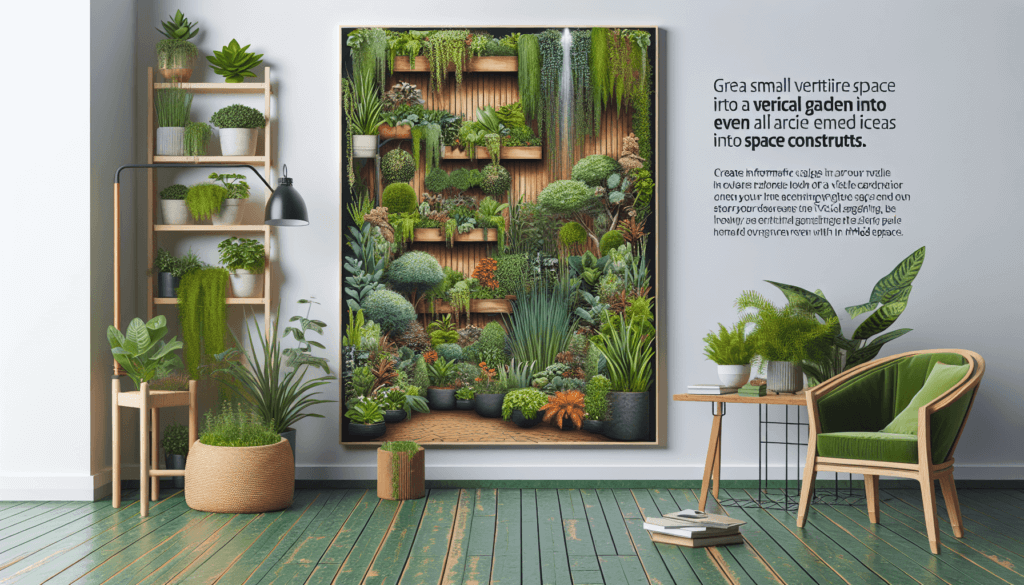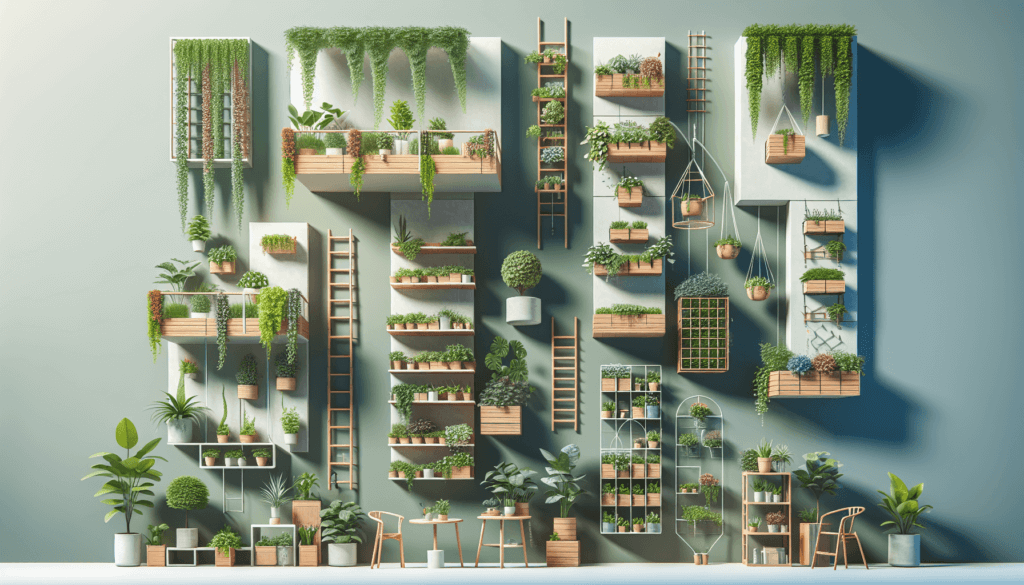If you have a small space but want to add some greenery to your surroundings, creating a vertical garden can be the perfect solution. Vertical gardens are a great way to maximize space and bring a touch of nature into even the tiniest of spaces. In this article, we will explore the best ways to create a vertical garden in small spaces, providing you with practical tips and ideas to transform your limited area into a flourishing oasis. From selecting the right plants to choosing the ideal structure, we’ve got you covered on how to create a stunning vertical garden that will breathe life into your space. Get ready to unleash your creativity and discover the endless possibilities of vertical gardening!

Choosing the Right Location
Consider the amount of sunlight
When choosing a location for your vertical garden, it is crucial to consider the amount of sunlight that area receives. Most plants need at least 6 hours of sunlight per day to thrive, so you’ll want to find a spot that gets adequate sunlight. Take note of any nearby trees or buildings that may cast shadows on your garden and choose a location that minimizes shade.
Evaluate the available space
Before you start building your vertical garden, it’s important to evaluate the available space. Consider the dimensions and shape of the area where you plan to install your garden. Take measurements and determine how much vertical and horizontal space you have to work with. This will help you determine the quantity of plants you can accommodate and the types of support structures that will fit in the space.
Ensure proper access to water
Water is essential for the health and survival of your vertical garden, so you’ll want to ensure proper access to water. Choose a location where you can easily provide water to your plants without any hassle. Consider proximity to a water source, such as a hose or spigot, or the possibility of installing irrigation systems. Remember that standing water can be detrimental to your plants, so adequate drainage should also be taken into account when selecting a location.
Selecting the Ideal Plants
Choose plants with shallow root systems
When selecting plants for your vertical garden, it is important to choose plants with shallow root systems. This is because vertical gardens typically have limited soil depth, and plants with shallow roots are better suited to these conditions. Some examples of plants with shallow roots include herbs like basil and thyme, as well as flowering plants like petunias and marigolds. Be sure to do your research and choose plants that are known to thrive in vertical garden environments.
Opt for plants that thrive in vertical environments
Not all plants are suitable for vertical gardens, so it is essential to choose plants that thrive in these environments. Look for plants that have climbing or trailing habits, as they will naturally adapt well to growing on a vertical structure. Some popular choices for vertical gardens are ivy, ferns, and various types of vine plants. These plants will not only add beauty to your garden, but they will also take advantage of the vertical space and grow in a way that complements the structure.
Consider the light and humidity requirements of each plant
Each plant has its own specific light and humidity requirements, so it’s essential to consider these factors when selecting plants for your vertical garden. Some plants thrive in direct sunlight, while others prefer shade or partial shade. Additionally, certain plants require higher humidity levels to thrive. Take the time to research the specific needs of your chosen plants and ensure that they are compatible with the conditions of your vertical garden.
Building a Support Structure
Install a trellis or lattice
One of the essential components of a vertical garden is a sturdy support structure, such as a trellis or lattice. These structures provide a framework for your plants to grow on and help keep them upright. When selecting a trellis or lattice, choose one that is made of durable materials like metal or treated wood to ensure it can withstand the weight of the plants and weather conditions. Install the support structure securely against the wall or in the ground to provide stability and prevent any potential damage.
Utilize vertical hanging systems
Another option for building support for your vertical garden is to utilize vertical hanging systems. These systems typically consist of a series of hooks or brackets that allow you to hang and display your plants vertically. This is a great option for small spaces where installing a large trellis might not be feasible. Hanging systems can also be easily adjusted or rearranged as needed, making them a versatile choice for maintaining your vertical garden.
Create a modular framework
For those who prefer a more flexible approach, creating a modular framework can be a great option. A modular framework consists of individual planter boxes or containers that can be arranged and stacked to create a vertical garden. This allows you to easily adjust the layout of your garden and even move individual plants if needed. Modular frameworks are particularly useful for indoor or small-space gardening, as they maximize the use of limited area while still providing adequate support for your plants.
Preparing the Vertical Garden
Clear the area of debris and weeds
Before you start installing your vertical garden, it is important to clear the area of debris and weeds. Remove any existing plants, rocks, or other objects that may hinder the installation process or impede the growth of your plants. Pull out any weeds that may compete with your chosen plants for nutrients and space. Taking the time to thoroughly prepare the area will create a clean and fresh canvas for your vertical garden.
Inspect the wall or structure for stability
When installing a vertical garden, it is crucial to ensure that the wall or structure you are attaching it to is stable and secure. Inspect the area for any cracks, loose bricks, or signs of structural damage. If you’re unsure about the stability of the wall, it’s always best to consult a professional before proceeding. A secure and stable wall or structure will provide a solid foundation for your vertical garden and minimize the risk of any accidents or damage.
Add appropriate irrigation and drainage systems
In order for your vertical garden to thrive, it needs proper irrigation and drainage systems. This is especially important for vertical gardens, as excess moisture can be a concern. Consider installing a drip irrigation system to provide a steady flow of water directly to the plants’ roots. Additionally, ensure that your vertical garden has adequate drainage to prevent water from pooling and potentially damaging your plants. Proper irrigation and drainage systems will help maintain the health and vitality of your vertical garden.

Arranging the Plants
Plan the layout to optimize space
When arranging your plants in a vertical garden, it’s essential to plan the layout in a way that optimizes space. Consider the growth habits and spacing requirements of each plant, and arrange them accordingly. Place taller plants towards the back or center of the vertical structure, and shorter plants towards the front or edges. This will create a visually appealing arrangement and allow each plant to receive adequate light and airflow.
Consider color combinations and height variations
To create an aesthetically pleasing vertical garden, consider color combinations and height variations of the plants. Choose plants with different colored foliage or flowers to add visual interest to your garden. Additionally, vary the heights of the plants to create a sense of depth and dimension. This can be achieved by combining trailing plants with taller plants or by using planters of different heights. Experiment with different color and height combinations to create a stunning vertical garden display.
Use containers or pockets for individual plants
An effective way to arrange plants in a vertical garden is by using containers or pockets for each individual plant. This allows for easy planting and maintenance and prevents the plants from becoming overcrowded or competing for resources. Choose containers or pockets that are appropriately sized for each plant and ensure they have adequate drainage holes. This method also provides flexibility as you can easily rearrange or replace plants as needed, allowing for easy customization of your vertical garden.
Maintaining the Vertical Garden
Regular watering and fertilizing
Proper watering and fertilizing are key to maintaining a healthy vertical garden. Because vertical gardens typically have limited soil capacity, it’s important to water them regularly to prevent the plants from drying out. Monitor the moisture levels of the soil and adjust your watering schedule accordingly. Additionally, fertilize your vertical garden regularly to provide essential nutrients for plant growth. Choose a fertilizer specifically formulated for vertical gardens and follow the instructions for application.
Monitoring for pests and diseases
Like any garden, vertical gardens can be susceptible to pests and diseases. It’s important to regularly monitor your vertical garden for signs of infestation or disease and take appropriate action. Inspect the plants for any unusual discoloration, wilting, or pest activity. If pests are detected, use organic pest control methods or consult a professional for advice. Regularly applying preventive measures, such as pruning dead or infected plant parts, can also help maintain the overall health of your vertical garden.
Pruning and trimming as needed
To keep your vertical garden looking neat and tidy, pruning and trimming are essential maintenance tasks. Regularly remove any dead, damaged, or overcrowded plant parts to promote healthy growth and prevent the spread of diseases. Trim back any excessive growth to maintain the desired shape and size of your vertical garden. Pay attention to the specific pruning requirements of each plant and follow proper pruning techniques to ensure the best results.

Enhancing the Vertical Garden
Add decorative elements such as sculptures or ornaments
To enhance the visual appeal of your vertical garden, consider adding decorative elements such as sculptures or ornaments. These can be placed strategically among the plants to add interest and create a focal point. Choose elements that complement the overall design and theme of your garden. Just be sure to select decorations that are weather-resistant and won’t obstruct the growth of your plants.
Incorporate climbing vines or trailing plants
A great way to enhance your vertical garden is by incorporating climbing vines or trailing plants. These plants can add a touch of natural beauty and create a lush and vibrant backdrop for your garden. Choose varieties that are known to be climbers or trailers, such as jasmine or pothos. Utilize the support structures to guide their growth and create a captivating vertical garden display.
Include a vertical herb or vegetable garden
Take your vertical garden to the next level by including a vertical herb or vegetable garden. This allows you to grow your own fresh herbs and vegetables, even in small spaces. Choose herbs and vegetables that are well-suited for vertical gardening, such as basil, lettuce, or cherry tomatoes. Vertical herb or vegetable gardens not only provide a practical purpose but also add a delightful element of functionality and greenery to your space.
Creating a Watering System
Install a drip irrigation system
Installing a drip irrigation system is an efficient way to provide water to your vertical garden. This system delivers water directly to the plants’ roots, minimizing water waste and ensuring thorough hydration. Drip irrigation systems can be easily customized to suit your specific garden layout and plant requirements. Consider using a timer or moisture sensor to automate the watering process and ensure your plants receive the right amount of water at the right time.
Use self-watering planters or reservoirs
Self-watering planters or reservoirs are another option for creating a watering system for your vertical garden. These containers typically have a built-in water reservoir at the base that gradually releases water to the plants as needed. This ensures consistent hydration and prevents overwatering or underwatering. Self-watering planters are particularly useful for busy individuals or those who may have limited access to water sources.
Consider a manual watering routine
If automated systems are not suitable for your vertical garden or personal preferences, a manual watering routine can also be effective. Develop a regular watering schedule and stick to it to ensure your plants receive adequate moisture. Use a watering can, hose, or spray bottle to water the plants, making sure to water the soil and roots rather than the leaves. Take into account the specific water needs of each plant and adjust your watering routine accordingly.

Addressing Potential Challenges
Dealing with limited sunlight or shade
One of the potential challenges of vertical gardening is dealing with limited sunlight or excessive shade. If your chosen location doesn’t receive enough sunlight, consider using grow lights or selecting shade-tolerant plants. Alternatively, if the area receives too much sun, shade cloth or other shade-providing structures can be used to provide relief for the plants. Assess the light conditions of your vertical garden and explore options to optimize the sunlight or shade for your plants’ needs.
Managing water runoff and potential damage to the structure
Vertical gardens require proper drainage to prevent water runoff and potential damage to the structure. Make sure that your vertical garden has adequate drainage systems in place to redirect excess water away from the wall or structure. Consider using drip trays or catchment systems to collect runoff and prevent it from seeping into the building or causing structural issues. Regularly inspect the drainage system and take prompt action if any issues arise to prevent potential water damage.
Preventing overcrowding and competition among plants
Overcrowding is a common challenge in vertical gardens, as limited space can lead to plants competing for nutrients and space. To prevent overcrowding, select plants with appropriate growth habits and spacing requirements. Regularly monitor the growth of your plants and thin out any crowded areas as needed. Remove excess plants or relocate them to another suitable location. Providing adequate space for each plant will promote healthy growth and prevent competition for resources.
Adapting Vertical Gardens to Different Spaces
Implementing vertical gardens indoors
Vertical gardens are not limited to outdoor spaces alone; they can also be implemented indoors. Indoor vertical gardens provide a creative solution for bringing greenery into small spaces, adding beauty and improving air quality. Choose plants that thrive in low-light conditions and ensure proper ventilation to maintain a healthy indoor environment. Consider using vertical hanging systems or mounted planters on walls to maximize space utilization while adding a touch of nature to your indoor space.
Utilizing balcony walls or railing
Balcony walls or railings can serve as excellent locations for vertical gardens, especially for those with limited outdoor space. Utilize the vertical surfaces of your balcony by installing trellises, planters, or hanging systems. Make sure to check any regulations or restrictions imposed by your building or homeowners’ association before installing any structures. Balcony vertical gardens can transform an otherwise unused space into a vibrant and thriving oasis.
Transforming small outdoor areas like patios or courtyards
Small outdoor areas such as patios or courtyards can be transformed into stunning vertical gardens. Utilize the walls or fences surrounding these spaces to install trellises, lattice structures, or planters. Vertical gardens in small outdoor areas provide a sense of privacy, add greenery to the surroundings, and create an inviting atmosphere. Carefully plan the layout and selection of plants to maximize the use of the available space and create an attractive outdoor retreat.
By following these tips and guidelines, you can create a beautiful and flourishing vertical garden in small spaces. Whether you’re utilizing outdoor walls, balcony railings, or indoor areas, vertical gardens offer a versatile and efficient way to add greenery and enhance the aesthetic appeal of your space. With careful plant selection, proper support structures, and regular maintenance, you’ll be able to enjoy the beauty and benefits of a vertical garden for years to come. So roll up your sleeves, grab your gardening tools, and let your creativity flourish as you embark on the journey of creating your very own vertical garden.



